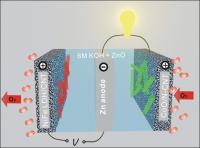
“High specific energy density more than twice that of lithium-ion technology.”
Stanford University scientists have developed an advanced zinc-air battery with higher catalytic activity and durability than similar batteries made with costly platinum and iridium catalysts. The results, published in the May 7 online edition of the journal Nature Communications, could lead to the development of a low-cost alternative to conventional lithium-ion batteries widely used today.
“There have been increasing demands for high-performance, inexpensive and safe batteries for portable electronics, electric vehicles and other energy storage applications,” said Hongjie Dai, a professor chemistry at Stanford and lead author of the study. “Metal-air batteries offer a possible low-cost solution.”
According to Dai, most attention has focused on lithium-ion batteries, despite their limited energy density (energy stored per unit volume), high cost and safety problems. “With ample supply of oxygen from the atmosphere, metal-air batteries have drastically higher theoretical energy density than either traditional aqueous batteries or lithium-ion batteries,” he said. “Among them, zinc-air is technically and economically the most viable option.”
Zinc-air batteries combine atmospheric oxygen and zinc metal in a liquid alkaline electrolyte to generate electricity with a byproduct of zinc oxide. When the process is reversed during recharging, oxygen and zinc metal are regenerated.
“Zinc-air batteries are attractive because of the abundance and low cost of zinc metal, as well as the non-flammable nature of aqueous electrolytes, which make the batteries inherently safe to operate,” Dai said. “Primary (non-rechargeable) zinc-air batteries have been commercialized for medical and telecommunication applications with limited power density. However, it remains a grand challenge to develop electrically rechargeable batteries, with the stumbling blocks being the lack of efficient and robust air catalysts, as well as the limited cycle life of the zinc electrodes.”
Active and durable electrocatalysts on the air electrode are required to catalyze the oxygen-reduction reaction during discharge and the oxygen-evolution reaction during recharge. In zinc-air batteries, both catalytic reactions are sluggish, Dai said.
Recently, his group has developed a number of high-performance electrocatalysts made with non-precious metal oxide or nanocrystals hybridized with carbon nanotubes. These catalysts produced higher catalytic activity and durability in alkaline electrolytes than catalysts made with platinum and other precious metals.
Stanford University scientists have developed an advanced zinc-air battery with higher catalytic activity and durability than similar batteries made with costly platinum and iridium catalysts. The results, published in the May 7 online edition of the journal Nature Communications, could lead to the development of a low-cost alternative to conventional lithium-ion batteries widely used today.
“There have been increasing demands for high-performance, inexpensive and safe batteries for portable electronics, electric vehicles and other energy storage applications,” said Hongjie Dai, a professor chemistry at Stanford and lead author of the study. “Metal-air batteries offer a possible low-cost solution.”
According to Dai, most attention has focused on lithium-ion batteries, despite their limited energy density (energy stored per unit volume), high cost and safety problems. “With ample supply of oxygen from the atmosphere, metal-air batteries have drastically higher theoretical energy density than either traditional aqueous batteries or lithium-ion batteries,” he said. “Among them, zinc-air is technically and economically the most viable option.”
Zinc-air batteries combine atmospheric oxygen and zinc metal in a liquid alkaline electrolyte to generate electricity with a byproduct of zinc oxide. When the process is reversed during recharging, oxygen and zinc metal are regenerated.
“Zinc-air batteries are attractive because of the abundance and low cost of zinc metal, as well as the non-flammable nature of aqueous electrolytes, which make the batteries inherently safe to operate,” Dai said. “Primary (non-rechargeable) zinc-air batteries have been commercialized for medical and telecommunication applications with limited power density. However, it remains a grand challenge to develop electrically rechargeable batteries, with the stumbling blocks being the lack of efficient and robust air catalysts, as well as the limited cycle life of the zinc electrodes.”
Active and durable electrocatalysts on the air electrode are required to catalyze the oxygen-reduction reaction during discharge and the oxygen-evolution reaction during recharge. In zinc-air batteries, both catalytic reactions are sluggish, Dai said.
Recently, his group has developed a number of high-performance electrocatalysts made with non-precious metal oxide or nanocrystals hybridized with carbon nanotubes. These catalysts produced higher catalytic activity and durability in alkaline electrolytes than catalysts made with platinum and other precious metals.
The Latest Bing News on:
Zinc-air battery
- Electric Vehicle Battery Market Size Expected to Reach USD 252.02 Bn by 2032on April 24, 2024 at 7:24 am
Hong Kong, April 24, 2024 (GLOBE NEWSWIRE) -- The global electric vehicle battery market size surpassed USD 64.51 billion in 2023 and is predicted to hit around USD 231.18 billion by 2031, a study ...
- Advanced Batteries and Sustainability - IDTechEx Experts Discuss Battery Technologieson April 23, 2024 at 4:02 am
Battery innovation underpins many sectors, including electric vehicles, sustainability, and renewable energy. In a recent episode of their technology podcast ' Tomorrow's Tech with IDTechEx ', ...
- Zinc battery people feeling confidenton April 21, 2024 at 9:46 am
Zinc batteries are generating confidence in 2024. This follows promising market outlooks announced at the 2024 annual International Zinc & Zinc Oxide Conferences, the forming of key commercialisation ...
- 'Stick, Click, Hear, ADHEAR.' - Jenevieve Butler discusses how ADHEAR workson April 18, 2024 at 8:08 am
The ADHEAR system consists of a bone conduction audio processor that is kept in place on the head with the ADHEAR adhesive adapter. ADHEAR is battery operated, using a size 13 zinc-air battery, ...
The Latest Google Headlines on:
Zinc-air battery
[google_news title=”” keyword=”zinc-air battery” num_posts=”10″ blurb_length=”0″ show_thumb=”left”]
The Latest Bing News on:
Metal-air batteries
- Batteries Newson April 28, 2024 at 5:00 pm
Drawing Inspiration from Plants: A Metal-Air Paper Battery for Wearable Devices Apr. 3, 2024 — Drawing inspiration from the way plants breathe, a group of researchers has created a paper-based ...
- U.S. EV battery upstart, Hyundai-Kia close in on lithium metal battery commercializationon April 24, 2024 at 3:06 pm
SES AI, a U.S. maker of electric vehicle batteries, aims to bring its next-gen lithium metal batteries to market as early as 2026 and is turbocharging the drive through a new agreement to jointly ...
- Engineering EV batteries for the 2030son April 22, 2024 at 9:02 pm
With SSBs being touted as a game-changer for EV battery technology, American SSB tech company QuantumScape has adopted a novel approach to battery design by doing away with the anode. Instead of an ...
- Composites end markets: Batteries and fuel cells (2024)on April 17, 2024 at 5:00 pm
The company’s decarbonization supermaterials are being tuned for a wide range of applications, including next-gen Li-S batteries for use in automotive, aerospace and defense market, among others.
- CATL’s Boss Doesn’t Think Solid-State Batteries Will Be Viable Any Time Soonon April 15, 2024 at 4:49 am
Robin Zeng, the man behind CATL, says that he supports solid-state batteries but believes they present problems that need to be overcome. For example, he says that to get the most out of them, they ...
- Researchers develop paper battery that generates power from water, airon April 5, 2024 at 12:30 pm
They’re found in flashlights, cameras, security systems, and even cell phones, tablets, vaping devices, tools, e-bikes, and Metal-air batteries use oxygen to generate electricity. The magnesium ...
- Drawing inspiration from plants: A metal–air paper battery for wearable deviceson April 3, 2024 at 8:28 am
Lightweight and thin paper-based devices help reduce dependence on metal or plastic materials ... on a high-performance magnesium–air (Mg–air) battery that is paper-based and activated ...
- Inspiration from plants: A metal-air paper battery for wearable deviceson April 2, 2024 at 4:59 pm
Lightweight and thin paper-based devices help reduce dependence on metal or plastic materials ... at Tohoku University has reported on a high-performance magnesium-air (Mg-air) battery that is ...
- Drawing inspiration from plants: A metal-air paper battery for wearable deviceson April 2, 2024 at 4:59 pm
Lightweight and thin paper-based devices help reduce dependence on metal or plastic materials ... on a high-performance magnesium-air (Mg-air) battery that is paper-based and activated by water.
The Latest Google Headlines on:
Metal-air batteries
[google_news title=”” keyword=”metal-air batteries” num_posts=”10″ blurb_length=”0″ show_thumb=”left”]











